
Description
Sandgrouse have small, pigeon-like heads and necks and sturdy compact bodies. They range in size from 24 to 40 centimetres (9.4 to 15.7 in) in length and from 150 to 500 grams (5.3 to 17.6 oz) in weight. The adults are sexually dimorphic with the males being slightly larger and more brightly colored than the females. They have eleven strong primary feathers and long pointed wings giving them a fast direct flight. The muscles of the wings are powerful and the birds are capable of rapid take off and sustained flight. In some species, the central feathers in the tail are extended into long points. The legs are short and members of the genus Syrrhaptes have feathers growing on both the legs and toes and no hind toes, while members of the genus Pterocles have legs feathered just at the front, no feathers on the toes and rudimentary hind toes raised off the ground.[1] The plumage is cryptic, generally being in shades of sandy brown, grey and buff, variously mottled and barred, enabling the birds to merge into the dusty landscape. There is a dense layer of under down which helps insulate the bird from extremes of heat and cold. The feathers of the belly are specially adapted for absorbing water and retaining it, allowing adults, particularly males, to carry water to chicks that may be many miles away from watering holes.[2][3] The amount of water that can be carried in this way is 15 to 20 millilitres (0.5 to 0.7 fluid ounce).[4]
Distribution
Pallas's sandgrouse in a field in the Gobi Desert
Members of the genus Pterocles are mainly found in the drier parts of northern, eastern and southern Africa though the range of some species extends into the Middle East and western Asia. The Madagascar sandgrouse is restricted to Madagascar. The black-bellied sandgrouse and the pin-tailed sandgrouse also occur in Spain, Portugal and southern France. Most species are sedentary though some make local migrations, typically to lower altitudes in winter.[4]
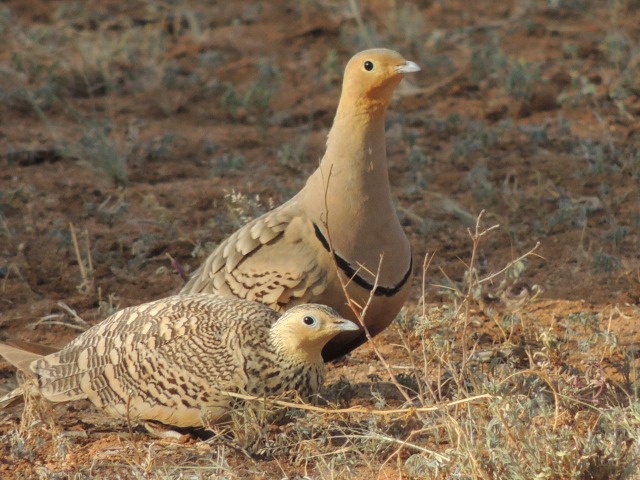
Behaviour and ecology
Diet and feeding
Namaqua sandgrouse are gregarious and feed and drink in large flocks
Sandgrouse are gregarious, feeding in flocks of up to 100 birds. As a consequence of their dry diet, they need to visit water sources regularly. Drinking times vary among the species. Ten species drink at dawn, four at dusk and two at indeterminate times.[1] When drinking, water is sucked into the beak which is then raised to let the water flow down into the crop. By repeating this procedure rapidly, enough water to last twenty four hours can be swallowed in a few seconds.[1] As they travel to water holes, they call to members of their own species and many hundreds or thousands synchronise their arrival at the drinking site despite converging from many different locations scattered over hundreds of square miles (kilometres) of territory.[6]
They are vulnerable to attack while watering but with a large number of birds milling about, predators find it difficult to select a target bird and are likely to have been spotted before they can get close to the flock.[3] The choice of a watering site is influenced by the topography of the nearby ground. The sandgrouse tend to avoid sites with cover for mammalian predators and their greatest risk is usually from predatory birds.[7] Sandgrouse travel tens of miles to their traditional water holes and tend to disregard temporary water sources which may appear periodically. This probably has a survival value because a dried up water source in an arid region could result in dehydration and death.[3] The Burchell's sandgrouse in the Kalahari Desert sometimes travels over 100 miles (160 km) daily to reach a water source.[4] Not all species need to drink every day, and the Tibetan sandgrouse does not need to travel to drink because of the abundance of water from melting snowfields in its habitat.[3]
Breeding
Chick of painted sandgrouse
Taxonomy
The Pteroclididae was formerly included in the Galliformes due to the similarities the family shares with the true grouse. However, it was later discovered that these similarities are superficial and a result of convergent evolution.[8] Sandgrouse were later placed near the Columbiformes largely due to their reported ability to drink by the "sucking" or "pumping" action of peristalsis of the esophagus, an unusual characteristic.[9] More recently, it has been reported that they cannot suck up water in this way,[10] and they are now treated separately in the order Pteroclidiformes. They have been considered near passerine birds and are considered by some to be closer to the shorebirds (Charadriiformes).[11]
In the DNA-study by Fain and Houde (2004)[12] they were included in the Metaves, together with the Columbiformes. In the larger study by Hackett et al. (2008)[13] they were once again positioned close to the Columbiformes, in Columbimorphae, but also with the Mesites. The intricately patterned, precocial downy young and egg colouration (though not shape) closely resemble those of many Charadriiformes. Eggs are near elliptical.[13]
Phylogeny
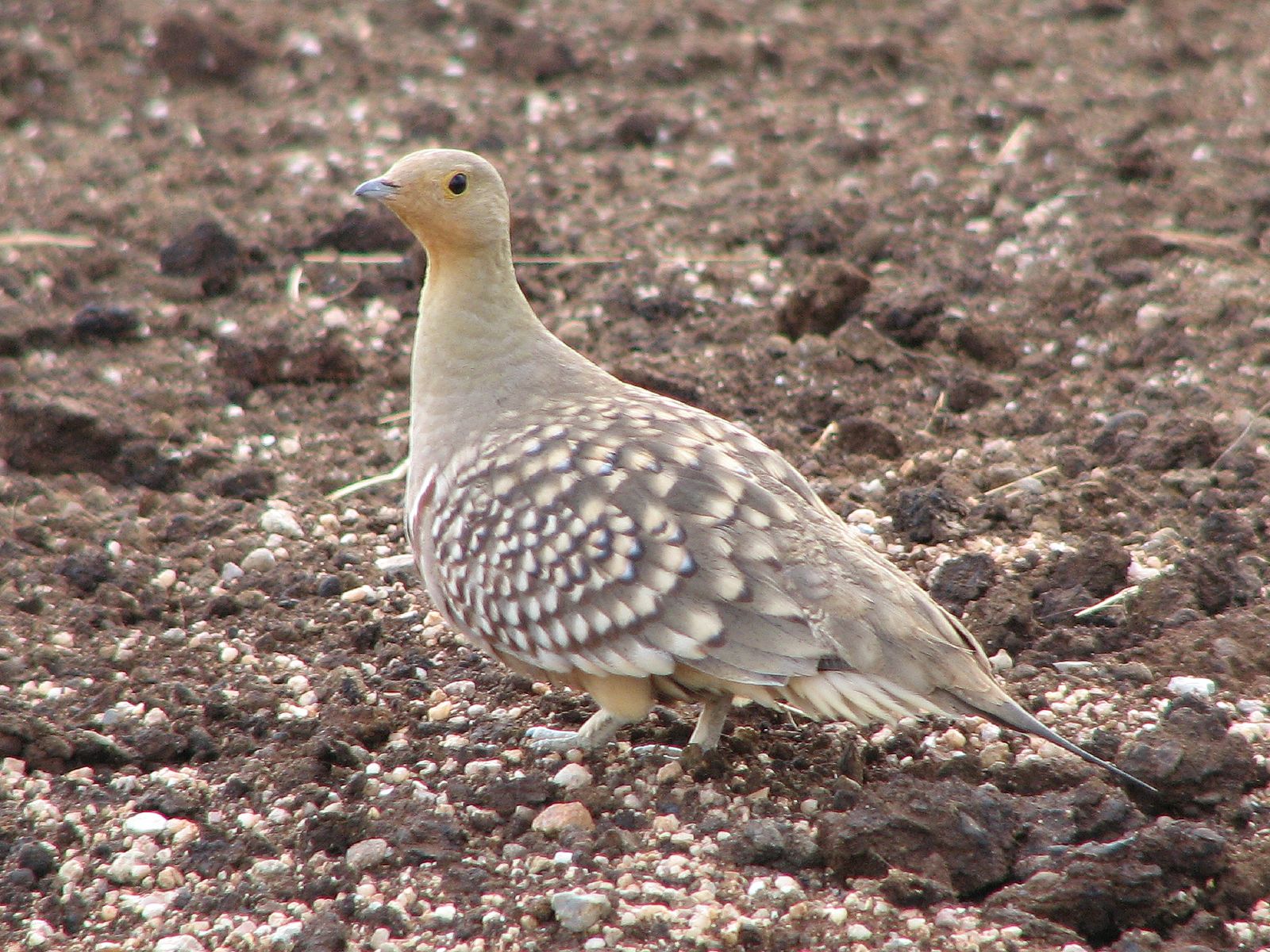
Living Pterocliformes based on the work by John Boyd.[14]
| Pteroclidae |
|
||||||||||||||||||||||||||||||||||||||||||||||||||||||||||||||||||||||||||||||||||||||||||
Species
| Sandgrouse | |||
|---|---|---|---|
| Common and binomial names[15] | Image | Description, range and status | Egg |
| Pin-tailed sandgrouse Pterocles alchata (Linnaeus, 1766) |
Length 31 to 39 centimetres (12 to 15 in) There are two subspecies:[16] P. a. alchata – Spain, Portugal, France, north west Africa P. a. caudacutus – Middle East, Turkey and eastward to Kazakhstan Status: Least concern |
||
| Double-banded sandgrouse Pterocles bicinctus Temminck, 1815 |
Length 31 to 39 centimetres (12 to 15 in) There are three subspecies:[17] P. b. ansorgei – south west Angola P. b. bicinctus – Namibia, Botswana, north west Cape Province P. b. multicolor – Zambia, Malawi, Mozambique and Transvaal Status: Least concern |
||
| Burchell's sandgrouse Pterocles burchelli Sclater, 1922 |
Length 25 cm (10 in) Monotypic[18] Angola, Namibia, Botswana, Zambia, Zimbabwe, South Africa Status: Least concern |
||
| Crowned sandgrouse Pterocles coronatus Lichtenstein, 1823 |
There are five subspecies:[19] P. c. atratus – Saudi Arabia, Iran, Afghanistan P. c. coronatus – Sahara, Morocco to Red Sea P. c. ladas – Pakistan P. c. saturatus – Oman P. c. vastitas – Sinai, Israel, Jordan Status: Least concern |
||
| Black-faced sandgrouse Pterocles decoratus Cabanis, 1868 |
There are three subspecies:[20] P. d. decoratus – south east Kenya and east Tanzania P. d. ellenbecki – north east Uganda, north Kenya, Ethiopia, Somalia P. d. loveridgei – west Kenya, west Tanzania Status: Least concern |
||
| Chestnut-bellied sandgrouse Pterocles exustus Temminck, 1825 (Pictured on left) |
There are six subspecies:[21] P. e. ellioti – Sudan, Eritrea, north Ethiopia, Somalia P. e. erlangeri – Saudi Arabia, Gulf States, Yemen P. e. exustus – Mauritania to Sudan P. e. floweri – Egypt (almost certainly extinct) P. e. hindustan – south east Iran, Pakistan, India P. e. olivascens – south Ethiopia, Kenya, north Tanzania Status: Least concern |
||
| Yellow-throated sandgrouse Pterocles gutturalis Smith, 1836 |
There are two subspecies:[22] P. g. gutturalis – south Zambia, Zimbabwe, Botswana, South Africa P. g. saturatior – Ethiopia, Kenya, Tanzania, north Zambia Status: Least concern |
||
| Painted sandgrouse Pterocles indicus Cabanis, 1868 |
Monotypic[23] India Status: Least concern |
||
| Lichtenstein's sandgrouse Pterocles lichtensteinii Temminck, 1825 |
There are five subspecies:[24] P. l. targius – Sahara, Sahel, south Morocco to Chad P. l. lichtensteinii – Israel, Sinai, Egypt, Sudan, Ethiopia, Somalia P. l. sukensis – Sudan, Ethiopia, Kenya P. l. ingramsi – Yemen P. l. arabicus – Saudi Arabia, Iran, Afghanistan, Pakistan Status: Least concern |
||
| Namaqua sandgrouse Pterocles namaqua (Gmelin, 1789) |
Length 31 to 39 centimetres (12 to 15 in) Monotypic[25] Angola, Namibia, Zimbabwe, Botswana, South Africa Status: Least concern |
||
| Black-bellied sandgrouse Pterocles orientalis (Linnaeus, 1758) |
There are two subspecies:[26] P. o. arenarius – Kazakhstan, Pakistan and western China P. o. orientalis – Northwest Africa, Canary Islands, Iberian Peninsula, Cyprus, Middle East, Turkey and Iran Status: Least concern |
||
| Madagascan sandgrouse Pterocles personatus Gould, 1843 |
Monotypic[27] Madagascar Status: Least concern |
||
| Four-banded sandgrouse Pterocles quadricinctus (Temminck, 1815) |
Length 25 to 28 centimetres (9.8 to 11.0 in) Monotypic[28] Central Africa Status: Least concern |
||
| Spotted sandgrouse Pterocles senegallus (Linnaeus, 1771) |
Length 33 centimetres (13 in) Monotypic[29] Northern Africa, Middle East and western Asia Status: Least concern |
||
| Tibetan sandgrouse Syrrhaptes tibetanus (Gould, 1850) |
Length 30 to 41 centimetres (12 to 16 in) Monotypic[30] Mountains of central Asia, Tibet and central China Status: Least concern |
||
| Pallas's sandgrouse Syrrhaptes paradoxus (Pallas, 1773) |
Length 30 to 41 centimetres (12 to 16 in) Monotypic[31] Mountains and steppes of central Asia Status: Least concern |
||


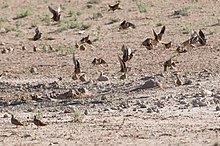

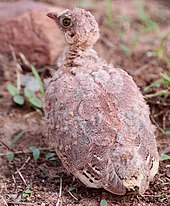



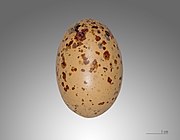


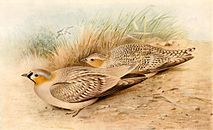
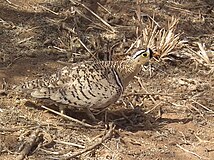
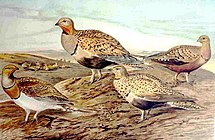



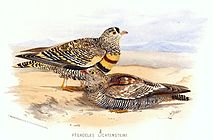


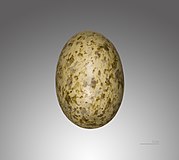





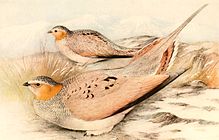

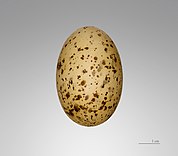
No comments:
Post a Comment
Note: Only a member of this blog may post a comment.